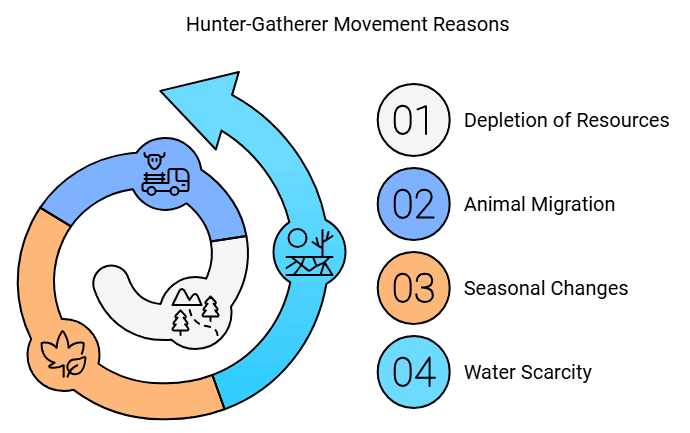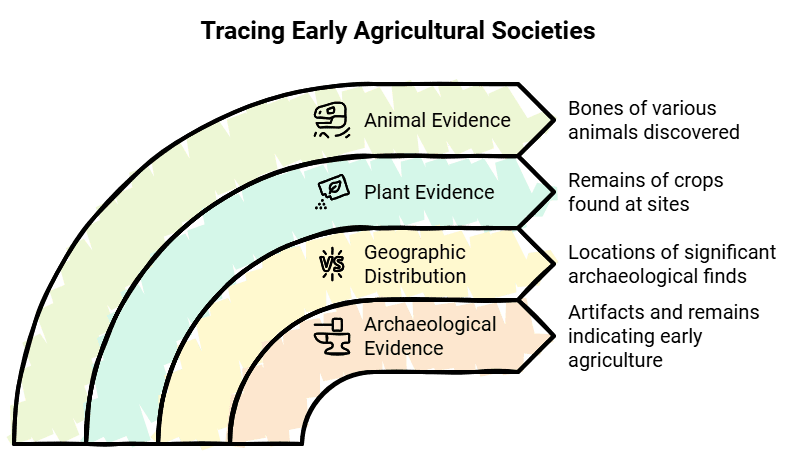Class 6 Exam > Class 6 Notes > Class 6 All Subjects (Old NCERT) > NCERT Summary: From Hunting-Gathering to Growing Food
From Hunting-Gathering to Growing Food Summary Class 6 Social Science Chapter 2
Hunter-gatherers
- The name comes from the way in which they got their food.
- Generally, they hunted wild animals, caught fish and birds, gathered fruits, roots, nuts, seeds, leaves, stalks and eggs.
- The reasons why hunter-gatherers moved from place to place:
- They eaten up all the available plants and animals resources where they stay for the long time, for the search of food they have to move from place to place.
- Some of the animals move from place to place in search for food that is why the hunters have to follow their movement.
- Because of seasons change some of the plants and trees don’t bear fruits so people have to move place to place in search of different kinds of plants.
- Plants, animals and people needs water, people need water during dry seasons that’s why they travelled on foot from place to place.

How do we know about these people?
• Archaeologists have found some of the things hunter-gatherers made and used.
• It is likely that people made and used tools of stone, wood and bone, of which stone tools have survived best.
Choosing a place to live in
- Many sites of hunter-gatherers were located near sources of water, such as rivers and lakes.
- Places where stone was found and where people made tools are known as factory sites.
- Sometimes, people lived here for longer spells of time. These sites are called habitation-cum-factory sites.
Making Stone Tools
- Stone tools were made using two techniques: stone on stone and pressure
Finding out about fire
- One of the biggest discoveries made by man was fire.
- Fire could have been used for many things: as a source of light, to roast meat, and to scare away animals.
A changing environment
- Around 12,000 years ago, the temperature of the world started increasing.
- In many areas, this led to the development of grasslands.
- This increased the number of deer, antelope, goat, sheep and cattle, i.e. animals that survived on grass.
- People started thinking about herding and rearing these animals themselves.
- Fishing also became important.
The beginnings of farming and herding
- Domestication is the process in which the man grows the plants and protects the animals. Most of these animals tended by man become different from there wild counterparts.
- People often select the animals and plants to be domesticated by them. This process of domestication began some 12,000 years ago.
- Virtually all the plant and animal produces which we eat today are the result of Domestication.
‘Storing’ animals
- Animals multiply naturally. Besides, if they are looked after carefully, they provide milk, which is an important source of food, and meat, whenever required.
- In other words, animals that are reared can be used as a ‘store’ of food.
Finding out about the first farmers and herders
- The archaeologists have found evidence of early farmers and herders.
- These are found all over the subcontinent.
- Some of the most important ones are in the north-west, in present-day Kashmir, and in east and south India.
- To prove that these settlements belonged to farmers and herders, scientists study the evidences of plants and animals.
- Scientists have found burnt grain at these sites. These grains could have been burnt accidentally or purposefully. Also, bones of different animals are found.
- Based on these finds scientists confirm that a number of crops plants and animals existed in different parts of India sub-continent.

Towards a settled life
- Archaeologists have found traces of many things. They have use these things to know how the ancient people lived, what did the ancient people eat etc.,
- Traces of huts at some sites. For example, in Burzahom (in Kashmir) people built pit-houses, which were dug into the ground, with steps leading into them. These houses may have provided shelter in cold weather.
- Cooking hearths: Cooking places were found both inside and outside the huts, which suggests that, depending on the weather, people could cook food either indoors or outdoors.
- Neolithic tools: Included polished stone tools to give cutting edge and mortar pistils used for grinding grains. Along with these Neolithic tools, even the tolls of Paleolithic age were still used.
- Farmers and herders live in groups called tribes.
Living and dying in Mehrgarh
- Mehrgarh site is located in a fertile plain, near the Bolan Pass, which is one of the most important routes into Iran.
- Mehrgarh was probably one of the places where women and men learnt to grow barley and wheat, and rear sheep and goats for the first time in this area.
- It is one of the earliest villages that we know about.
The document From Hunting-Gathering to Growing Food Summary Class 6 Social Science Chapter 2 is a part of the Class 6 Course Class 6 All Subjects (Old NCERT).
All you need of Class 6 at this link: Class 6
|
297 videos|1066 docs|204 tests
|
FAQs on From Hunting-Gathering to Growing Food Summary Class 6 Social Science Chapter 2
| 1. What are the main characteristics of hunter-gatherer societies? |  |
Ans. Hunter-gatherer societies are typically characterized by their nomadic lifestyle, relying on foraging, hunting, and fishing for subsistence. They move frequently in search of food and resources, live in small groups or bands, and have a deep knowledge of their environment. Their social structures are often egalitarian, with shared responsibilities and resources.
| 2. How did the transition from hunting-gathering to agriculture occur? |  |
Ans. The transition from hunting-gathering to agriculture occurred over thousands of years, influenced by changes in climate, population growth, and the domestication of plants and animals. As certain regions became more conducive to farming, communities began to settle in one place, cultivate crops, and raise livestock, leading to the establishment of permanent settlements.
| 3. What were the impacts of agriculture on human societies? |  |
Ans. The advent of agriculture led to significant changes in human societies, including the development of permanent settlements, population growth, and the rise of social hierarchies. It allowed for surplus food production, which contributed to trade and the establishment of complex societies, but also led to challenges such as land ownership disputes and reliance on fewer crop varieties.
| 4. How did the lifestyle of hunter-gatherers differ from that of early agricultural societies? |  |
Ans. Hunter-gatherers had a mobile lifestyle, constantly moving to find food, which required a deep understanding of their environment. In contrast, early agricultural societies developed sedentary lifestyles, establishing permanent homes and communities. This shift allowed for more complex social structures, but also led to increased labor demands and social stratification.
| 5. What role did climate change play in the transition from hunting-gathering to farming? |  |
Ans. Climate change played a crucial role in the transition from hunting-gathering to farming by altering the availability of resources. The end of the last Ice Age resulted in warmer temperatures and more stable climates, creating favorable conditions for plant growth. This shift encouraged humans to experiment with cultivating wild grains, eventually leading to the domestication of various crops and the rise of agriculture.
Related Searches

















